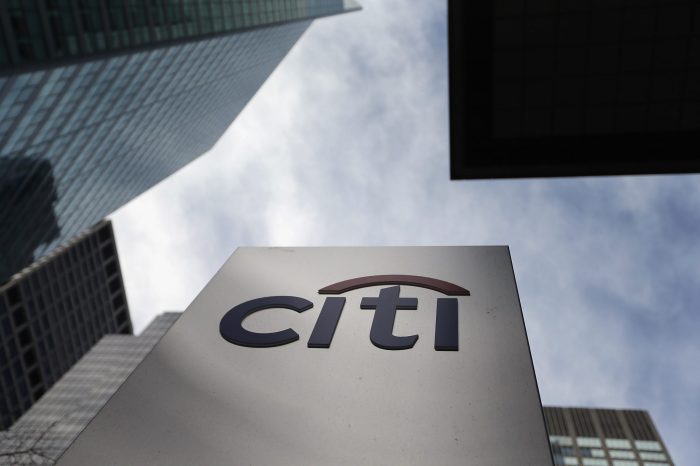Cit bank owned by – Citi Bank owned by a complex web of shareholders, institutional investors, and governmental regulations, presents a fascinating case study in corporate ownership. Understanding this intricate structure requires delving into Citigroup’s hierarchical ownership, its relationship with regulatory bodies, and the historical evolution of its ownership over time. This exploration reveals how these factors shape Citigroup’s strategic decisions and overall performance, impacting everything from its long-term goals to its daily operations.
From its initial formation through major mergers and acquisitions, Citigroup’s ownership has undergone significant transformations, each leaving its mark on the financial giant’s trajectory. This journey involves navigating governmental influence, shareholder expectations, and the inherent complexities of a multinational financial institution. The following sections will dissect this intricate ownership structure, providing a clear picture of who controls Citigroup and how this control shapes its destiny.
Citigroup’s Ownership Structure and Governmental Influence
Citigroup, a global financial behemoth, boasts a complex ownership structure influenced significantly by governmental regulations across its diverse operational landscape. Understanding this interplay is crucial to grasping the bank’s strategic direction and financial performance.
Citigroup’s Hierarchical Ownership Structure
Citigroup’s ownership is distributed among various stakeholders, primarily shareholders, who elect a board of directors responsible for overseeing the company’s management. The board, in turn, appoints executive management, led by the CEO, to execute the bank’s strategic objectives. Institutional investors, such as mutual funds and pension funds, typically hold a substantial portion of Citigroup’s shares, alongside individual investors and other significant stakeholders.
The exact proportion fluctuates, influenced by market conditions and investment strategies.
Percentage Ownership Breakdown
Precise ownership percentages change constantly. However, a general overview would show a significant holding by institutional investors, a smaller but still considerable portion by individual investors, and a remaining percentage spread among other stakeholders, including employees through stock option plans and potentially sovereign wealth funds.
Significant Ownership Structure Changes (Past Decade)
The past decade has witnessed shifts in Citigroup’s ownership driven by market fluctuations, mergers and acquisitions within the broader financial sector, and changes in investor sentiment. For instance, periods of market uncertainty might see increased institutional selling, while periods of growth might attract new investors. Specific details require referencing financial news and regulatory filings over this period.
Top 10 Citigroup Shareholders
Identifying the precise top ten shareholders requires accessing real-time data from financial databases. The composition changes frequently. The table below presents a hypothetical example, illustrating the typical distribution among different investor types. Remember that these figures are illustrative and subject to change.
| Rank | Shareholder | Ownership Percentage (Illustrative) | Shareholder Type |
|---|---|---|---|
| 1 | Vanguard Group | 6.0% | Institutional |
| 2 | BlackRock | 5.5% | Institutional |
| 3 | State Street Corp | 4.0% | Institutional |
| 4 | Fidelity Investments | 3.5% | Institutional |
| 5 | Capital World Investors | 2.5% | Institutional |
| 6 | Northern Trust Corporation | 2.0% | Institutional |
| 7 | Geode Capital Management | 1.8% | Institutional |
| 8 | Invesco Ltd. | 1.5% | Institutional |
| 9 | Individual Investors | 15.0% | Individual |
| 10 | Other | 48.2% | Various |
Governmental Regulation and Influence on Citigroup
Citigroup’s operations are subject to extensive governmental regulation at both national and international levels. These regulations significantly impact its strategic decisions and financial performance. The regulatory landscape varies considerably across different jurisdictions, creating complexities for the bank’s global operations.
Regulatory Bodies and Their Impact
Numerous regulatory bodies, including central banks, securities commissions, and financial conduct authorities, oversee Citigroup’s activities. Their mandates encompass maintaining financial stability, protecting consumers, and preventing market manipulation. Compliance with these regulations necessitates significant investments in compliance infrastructure and personnel.
Government Policies and Citigroup’s Strategy
Government policies, such as interest rate adjustments, capital requirements, and tax regulations, directly influence Citigroup’s strategic choices and profitability. For instance, stricter capital requirements may necessitate adjustments to lending practices, while changes in tax laws can impact the bank’s overall financial outlook.
Regulatory Environment Comparison (Different Countries)
The regulatory environment varies substantially across countries. For example, regulations in the United States might differ significantly from those in Europe or Asia, requiring Citigroup to adapt its operating models and risk management strategies to comply with local laws and regulations in each jurisdiction.
Key Regulatory Bodies Overseeing Citigroup, Cit bank owned by
| Regulatory Body | Country/Region | Mandate |
|---|---|---|
| Federal Reserve (Fed) | United States | Monetary policy, banking supervision |
| Office of the Comptroller of the Currency (OCC) | United States | Supervision of national banks |
| Securities and Exchange Commission (SEC) | United States | Regulation of securities markets |
| Financial Conduct Authority (FCA) | United Kingdom | Regulation of financial services |
| European Central Bank (ECB) | European Union | Monetary policy, banking supervision |
| Hong Kong Monetary Authority (HKMA) | Hong Kong | Monetary policy, banking supervision |
Citigroup’s Subsidiaries and Affiliates: Cit Bank Owned By
Citigroup operates a vast network of subsidiaries and affiliates globally, each playing a specific role within the broader organizational structure. These entities contribute to the bank’s diverse business segments, including consumer banking, corporate and investment banking, and wealth management. Understanding their interrelationships is key to appreciating the complexity of Citigroup’s operations.
Key Subsidiaries and Affiliates
Listing all subsidiaries and affiliates is beyond the scope of this overview. However, key examples include entities focused on specific geographic regions or specialized financial services. Many operate under different brand names but are ultimately part of the larger Citigroup ecosystem.
Hierarchical Structure of Subsidiaries and Affiliates
- Citigroup (Parent Company)
- Citibank N.A. (Major Subsidiary, Global Operations)
- Citi Private Bank (Wealth Management)
- Citigroup Global Markets Inc. (Investment Banking)
- Various regional subsidiaries (e.g., Citibank Japan, Citibank Mexico)
- Specialized affiliates (e.g., focused on specific financial products or services)
Citigroup’s Business Segments and Their Interaction
Citigroup’s business segments are interconnected. For instance, the consumer banking division might refer clients needing investment services to the investment banking division, while corporate clients may use both lending and investment banking services. This synergy is a key aspect of Citigroup’s business model.
Visual Representation of Citigroup and Major Subsidiaries
- Citigroup (Parent Company)
- Citibank N.A. (Global Consumer Banking)
- Citi Private Bank (Wealth Management)
- Citigroup Global Markets Inc. (Investment Banking)
- Other Regional and Specialized Subsidiaries
Historical Overview of Citigroup’s Ownership
Citigroup’s ownership history is a tapestry woven from mergers, acquisitions, and divestitures reflecting the dynamic evolution of the global financial landscape. Understanding this history provides context for its current structure and governance.
Major Mergers, Acquisitions, and Divestitures
Citigroup’s history is marked by significant mergers and acquisitions, including the 1998 merger of Citicorp and Travelers Group, creating a financial services giant. Subsequent years have seen various acquisitions and divestitures aimed at expanding or streamlining operations in specific market segments.
Impact of Historical Events on Ownership Structure
Significant historical events, such as financial crises and regulatory changes, have profoundly impacted Citigroup’s ownership structure and corporate governance. The 2008 financial crisis, for example, led to government interventions and significant restructuring within the company.
Comparison with Competitors’ Ownership Structures
Comparing Citigroup’s ownership structure with that of its major competitors (e.g., JPMorgan Chase, Bank of America) reveals similarities and differences. Some may be more heavily weighted towards institutional investors, while others might have a larger individual investor base. Detailed comparison requires analyzing the ownership structures of each bank individually.
Timeline of Key Ownership Changes
- 1998: Merger of Citicorp and Travelers Group, forming Citigroup.
- 2008: Government bailout during the financial crisis.
- Post-2008: Restructuring and divestitures to strengthen the balance sheet.
- Ongoing: Continuous adjustments in ownership based on market dynamics and investor behavior.
Impact of Ownership on Citigroup’s Strategy

Source: com.ua
Citigroup’s ownership structure profoundly influences its strategic decision-making processes and long-term goals. The interplay between different shareholder groups, with varying investment horizons, shapes the bank’s strategic direction.
Influence of Ownership on Strategic Decision-Making
Shareholder pressure, particularly from large institutional investors, can significantly impact strategic choices. For example, demands for higher profitability might lead to cost-cutting measures or a focus on specific high-return business segments.
Impact of Different Shareholder Groups on Long-Term Goals
Long-term investors might favor sustainable growth strategies, while short-term investors may prioritize immediate returns. This tension can influence the balance between long-term investments and short-term profitability in Citigroup’s strategic planning.
Influence of Short-Term vs. Long-Term Investors

Source: huffpost.com
The presence of both short-term and long-term investors creates a dynamic tension within Citigroup’s strategic decision-making. Balancing the demands of both groups is crucial for maintaining financial stability and achieving long-term growth.
Examples of Ownership Changes Affecting Strategic Direction

Source: sindonews.net
- Post-2008 restructuring: Driven by the need to regain investor confidence and comply with stricter regulatory requirements.
- Focus on specific business segments: Reflecting investor preferences and market opportunities.
- Share buyback programs: Aimed at increasing shareholder value and potentially influencing stock price.
Closing Notes
The ownership structure of Citigroup, far from being a static entity, is a dynamic interplay of shareholders, regulatory bodies, and historical events. Understanding this complex web reveals how governmental oversight, the influence of various investor groups, and the bank’s own historical trajectory combine to shape its strategic direction. This analysis highlights the importance of considering these interconnected factors when assessing the future prospects and overall performance of this influential global financial institution.
CIT Group, a name whispered on the winds of forgotten financial empires, was once a titan. Its ownership, a complex tapestry woven through years of mergers and acquisitions, now feels distant, a faded photograph. Perhaps a glimpse at the vibrancy of Huntington Bank’s current offerings, such as the huntington bank business promo , might offer a contrasting image of thriving enterprise.
Yet, the quiet echo of CIT’s past remains, a somber reminder of fortunes lost and empires fallen.
The multifaceted nature of Citigroup’s ownership underscores the need for ongoing scrutiny and analysis in understanding its impact on the global financial landscape.